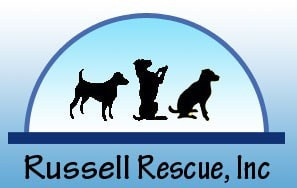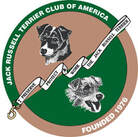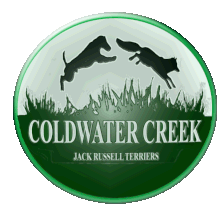|
OK so let me start by saying, we’ve all been there, where you are now. You have or are looking for a JRT and those terrier trials look like fun. Well let me tell you they are. Starting out on a field trial adventure with your Jack Russell Terrier can be one of the most challenging, exasperating and rewarding things you have ever done. You may never see your dog’s full potential until you take them to a Terrier trial. Let me tell you when I saw Wingo Ranch Amazing Grace turn from a lap dog into a competitor at her first trial it was, well, amazing. I mean it was like watching Bruce Banner turn into the incredible hulk, on my lap, and I had the scratches to prove it. When I say we have all been there I mean it. We have all worried about our dog barking too much at a trial ( no one hears it ),or how to dress, ( It’s not Cuft’s), and all the other questions that come along with learning something new. But if you show up at a trial or funday you will soon realize that your dog is welcome and most likely you as well. All kidding aside, the JRTCA is made up of some of the most wonderful and wild people I have ever met, for sure we have a Terrier nature, but admit it, if you have or are looking for a Jack, you do too. Here are my top 3 things to do when you are preparing to go to a JRT Trial.
What You Will Need: Checkout Fuzzy Gidget's store for Links to our recommendations.
How to Get Your Dog Ready: Your dog has been bred for this but a little work ahead of time will make your life easier,
These are the top 5 things not to do at a JRT trial.
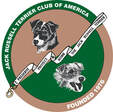 Where to Look for More Information
We have all been there:
|
| I couldn't believe it when I received a message from the Talamasca, an organization that studies the paranormal, informing me that my Jack Russell Terrier, Amazing Grace, is a time traveler. They sent me photos of her with George Washington crossing the Delaware, Van Gogh, Gauguin, and Picasso, Ringo Starr and Prince Harry, the Dalai Lama, and even Alfred Hitchcock. I was in shock! The Talamasca informed me that Grace was taken by the Defense Advanced Research Projects Agency (DARPA) to study her time-traveling abilities, but she kept disappearing from their testing facility and ended up back on our couch. Apparently, they couldn't contain her! I started to notice things that I hadn't before, like how Grace had a penchant for classical music, and I wondered if she had been present when some of the famous works were composed. Maybe she had inspired some of the great composers! I started to compile a list of songs that may have been inspired by her, including "Fur Elise" by Beethoven, "Eine Kleine Nachtmusik" by Mozart, and "Rhapsody in Blue" by Gershwin. But it wasn't just music. I found paintings and photos of Grace throughout history. She was even in the movie "Yellow Submarine" with The Beatles! I couldn't help but imagine what other adventures she had been on. Maybe she was there when the pyramids were built, or when Neil Armstrong took his first steps on the moon. The possibilities were endless! In the end, I realized that having a time-traveling Jack Russell Terrier was just another unexpected twist in my life. Who knows where Grace will take me next? All I know is that it will be a wild ride filled with humor and excitement, and I can't wait to see what she has in store for me next. | |
Hunting with your Jack Russell Terrier is not just a fun activity, it's a primal experience that taps into a deep connection between humans and dogs that has been around for thousands of years. Humans and dogs have been working together for hunting purposes for a long time, in fact some researchers now believe we have been hunting together for over one hundred thousand years.
Remarkably, a hunter-gatherer human with a dog is up to six times more effective at hunting than a human alone. That's right, six times! It's no wonder that humans and dogs have been such a successful hunting team throughout history.
So, what makes dogs such great hunting companions? It all goes back to their wild ancestor, the wolf. Over thousands of years of domestication and selective breeding, dogs have developed traits that make them better hunting partners for humans. For example, dogs have evolved to be more social and attuned to human communication, which makes them better at understanding and interpreting our body language, voice, and facial expressions.
In fact, studies have shown that dogs are able to read human emotions and intentions just by looking at our facial expressions. This is especially true for Jack Russell Terriers, which are known for their intelligence and attentiveness.
But it's not just about the science of it all. Hunting with your Jack Russell Terrier is also a great way to tap into your primal instincts and connect with nature. There's something special about being out in the wild with your canine companion, working together to track down prey.
Of course, hunting with your Jack Russell Terrier requires proper training and care. You need to make sure your dog is well-trained and obedient, and that you follow all hunting regulations and safety guidelines. But with the right preparation and attitude, hunting with your Jack Russell Terrier can be an exciting and fulfilling experience that brings you closer to your furry friend and the natural world.
So, if you're looking for a way to tap into your primal instincts and bond with your Jack Russell Terrier, consider taking up hunting together. It's a timeless activity that has brought humans and dogs together for thousands of years, and the JRTCA is a great place to start your trip into the wild.
Training a new puppy can be an exciting, yet challenging experience. It requires patience, consistency, and a deep understanding of how your own mind works. Understanding your own mind is the key to effectively training your new new companion, and it begins with recognizing that your puppy's mind is composed of three different developing areas of influence.
The first area of influence is instinct.
Instinct is the natural, unlearned behavior that your puppy exhibits. It's a survival mechanism that helps your puppy navigate the world around them. For example, a puppy's instinct might be to chew on things to relieve teething pain. Instincts like marking in a male are hard to train over because they are hard wired so understanding your puppy's instinctual behavior is the first step in training them effectively.
The second area of influence is the conscious director.
This is the part of your puppy's mind that makes decisions based on experience and learning. It's the part of your puppy's mind that does the training. Positive reinforcement is a highly effective method of training your puppy's conscious director. Positive reinforcement involves rewarding your puppy when they exhibit the desired behavior. For example, if you want your puppy to sit, you would give them a treat when they sit on command. This type of training helps your puppy associate good behavior with rewards.
The third area of influence is learned behavior.
Learned behavior is the result of experience and training. It's the behavior that your puppy learns through repetition and reinforcement. Aversion training is another highly effective method of training your puppy's learned behavior. Aversion training involves using negative consequences to discourage undesirable behavior. For example, if your puppy chews on your furniture, you might use a bitter spray to discourage them from chewing on it in the future.
The key to effectively training your puppy is to use a combination of positive reinforcement and aversion training the carrot and the stick, metaphorically on the stick. By using both methods, you can write over instinctual behavior and encourage your puppy to exhibit desirable behavior. Positive reinforcement helps your puppy associate good behavior with rewards, while aversion training discourages undesirable behavior.
This training method can have many benefits for dog owners. Not only can it help you establish a strong bond with your puppy, but it can also help prevent behavioral problems in the future. By understanding your own mind and your puppy's mind, you can create a positive and healthy relationship with your furry friend.
This mind-altering concept of understanding your own mind and using a combination of positive reinforcement and aversion training can also be used to retrain ourselves. Just as we can train our puppies to exhibit desirable behavior, we can use the same methods to train ourselves to adopt positive habits and break negative ones. By understanding the power of our own minds, we can create positive change in ourselves and our little wolves.
The first area of influence is instinct.
Instinct is the natural, unlearned behavior that your puppy exhibits. It's a survival mechanism that helps your puppy navigate the world around them. For example, a puppy's instinct might be to chew on things to relieve teething pain. Instincts like marking in a male are hard to train over because they are hard wired so understanding your puppy's instinctual behavior is the first step in training them effectively.
The second area of influence is the conscious director.
This is the part of your puppy's mind that makes decisions based on experience and learning. It's the part of your puppy's mind that does the training. Positive reinforcement is a highly effective method of training your puppy's conscious director. Positive reinforcement involves rewarding your puppy when they exhibit the desired behavior. For example, if you want your puppy to sit, you would give them a treat when they sit on command. This type of training helps your puppy associate good behavior with rewards.
The third area of influence is learned behavior.
Learned behavior is the result of experience and training. It's the behavior that your puppy learns through repetition and reinforcement. Aversion training is another highly effective method of training your puppy's learned behavior. Aversion training involves using negative consequences to discourage undesirable behavior. For example, if your puppy chews on your furniture, you might use a bitter spray to discourage them from chewing on it in the future.
The key to effectively training your puppy is to use a combination of positive reinforcement and aversion training the carrot and the stick, metaphorically on the stick. By using both methods, you can write over instinctual behavior and encourage your puppy to exhibit desirable behavior. Positive reinforcement helps your puppy associate good behavior with rewards, while aversion training discourages undesirable behavior.
This training method can have many benefits for dog owners. Not only can it help you establish a strong bond with your puppy, but it can also help prevent behavioral problems in the future. By understanding your own mind and your puppy's mind, you can create a positive and healthy relationship with your furry friend.
This mind-altering concept of understanding your own mind and using a combination of positive reinforcement and aversion training can also be used to retrain ourselves. Just as we can train our puppies to exhibit desirable behavior, we can use the same methods to train ourselves to adopt positive habits and break negative ones. By understanding the power of our own minds, we can create positive change in ourselves and our little wolves.
My thoughts on how to cope with the loss of a pet.
“We are like immortal beings to our dogs. We live our lives while they burn through theirs, fast and bright. We watch as they arrive, mature, grow grey, and pass. Hopefully, we have paid attention.” - RHKohl
As dog breeders, Pam and I have spoken with many people who have lost a family pet and are looking for a puppy. In some cases, we think that the person we are talking to isn't ready for the challenge that a new puppy will bring. They are still in the first or second stage of grieving over their loss. We feel for these folks and with this in mind, we would like to give you our thoughts on how to cope with the loss of a pet and when you might be ready to look for a new puppy.
Perspective: Please, if you are having trouble dealing with grief and loss and cannot put things into perspective, then find a mental health professional.
My thoughts on how to cope with the loss of a family pet:
I think we go through the grieving process after the loss of a pet in three stages:
• Denial – samudaya
• Acceptance
• Letting Go - nirodha
I also think that we go through these stages in both our conscious mind and our id or unconscious mind. The unconscious mind is where your childlike nature lives. It's where artists and creative people spend most of their time. The unconscious mind is the crying baby in us. It's the angry Karen and it's the stage actor in each of us. The unconscious mind is also where we feel the loss of a pet most deeply. Thankfully, somewhere around the age of two (in most of us), the other part of our human nature begins to mature. This is when our conscious mind begins to gain more control over our thoughts and actions. We are then young adults, meaning we are learning self-control. This is when we become more self-aware and adult-like.
The problem is that when we grieve, we grieve as a child, in our unconscious mind. But thankfully, as conscious beings, we have a way out of the hopeless feeling of grief. The key here is to realize that we can use our conscious or adult-like mind to comfort and guide the child in us to accept what has happened. It might seem strange to say you can comfort yourself, but how many times were you told “control yourself” as a child? In reality, there is little difference.
Just a Note: Please be careful with sadness; if you stay here too long and do not accept the reality of things, sadness can turn into depression. If you can't get past the loss, find a mental health professional to help you through.
“Watch out now Take care,
beware the thoughts that linger
Winding up inside your head
The hopelessness around you In the dead of night
Beware of sadness
It can hit you It can hurt you
Make you sore, and what is more
That is not what you are here for”
Some things that might help:
• Your faith
• Remember to breathe!
• Stay in the moment and out of your head.
• Sleep (not too much - not too little)
• Eat well. • Get out and walk.
• Meet with friends.
• Meditate – Gil Fronsdal has a class online.
How to know when you are ready for a new challenge:
• If you are honest with yourself, you will know.
• You can talk about the pet without becoming overly emotional.
Additional suggestions to cope with the loss of a pet:
• Write about your feelings in a journal.
• Create a memorial for your pet.
• Volunteer at an animal shelter or rescue organization.
I hope this helps in some small way.
“We are like immortal beings to our dogs. We live our lives while they burn through theirs, fast and bright. We watch as they arrive, mature, grow grey, and pass. Hopefully, we have paid attention.” - RHKohl
As dog breeders, Pam and I have spoken with many people who have lost a family pet and are looking for a puppy. In some cases, we think that the person we are talking to isn't ready for the challenge that a new puppy will bring. They are still in the first or second stage of grieving over their loss. We feel for these folks and with this in mind, we would like to give you our thoughts on how to cope with the loss of a pet and when you might be ready to look for a new puppy.
Perspective: Please, if you are having trouble dealing with grief and loss and cannot put things into perspective, then find a mental health professional.
My thoughts on how to cope with the loss of a family pet:
I think we go through the grieving process after the loss of a pet in three stages:
• Denial – samudaya
• Acceptance
• Letting Go - nirodha
I also think that we go through these stages in both our conscious mind and our id or unconscious mind. The unconscious mind is where your childlike nature lives. It's where artists and creative people spend most of their time. The unconscious mind is the crying baby in us. It's the angry Karen and it's the stage actor in each of us. The unconscious mind is also where we feel the loss of a pet most deeply. Thankfully, somewhere around the age of two (in most of us), the other part of our human nature begins to mature. This is when our conscious mind begins to gain more control over our thoughts and actions. We are then young adults, meaning we are learning self-control. This is when we become more self-aware and adult-like.
The problem is that when we grieve, we grieve as a child, in our unconscious mind. But thankfully, as conscious beings, we have a way out of the hopeless feeling of grief. The key here is to realize that we can use our conscious or adult-like mind to comfort and guide the child in us to accept what has happened. It might seem strange to say you can comfort yourself, but how many times were you told “control yourself” as a child? In reality, there is little difference.
Just a Note: Please be careful with sadness; if you stay here too long and do not accept the reality of things, sadness can turn into depression. If you can't get past the loss, find a mental health professional to help you through.
“Watch out now Take care,
beware the thoughts that linger
Winding up inside your head
The hopelessness around you In the dead of night
Beware of sadness
It can hit you It can hurt you
Make you sore, and what is more
That is not what you are here for”
- George Harrison
Some things that might help:
• Your faith
• Remember to breathe!
• Stay in the moment and out of your head.
• Sleep (not too much - not too little)
• Eat well. • Get out and walk.
• Meet with friends.
• Meditate – Gil Fronsdal has a class online.
How to know when you are ready for a new challenge:
• If you are honest with yourself, you will know.
• You can talk about the pet without becoming overly emotional.
Additional suggestions to cope with the loss of a pet:
• Write about your feelings in a journal.
• Create a memorial for your pet.
• Volunteer at an animal shelter or rescue organization.
I hope this helps in some small way.
Welcome to Jack Russell Maniacs where we talk Jack! Today, we'll be discussing what questions a Jack Russell Terrier breeder should ask a prospective new puppy owner, and why it's important to do so." Coldwater Creek Jack Russell Terriers is a member of the Jack Russell Terrier Club of America. The JRTCA is the breed registry for the real Jack Russell Terrier. All our dogs are registered with the JRTCA. As a JRT breeder, we feel we have a responsibility not only our own dogs, but to all the Jack Russell Terriers in shelters and rescue organizations. So we breed for a purpose. We want to make sure that our puppies go to a loving and caring home, where they will receive proper care, attention, and training." We do not breed for financial gain, in fact, if you take into account the time and money required to breed, keep the mother healthy during the prenatal stage, Vet visits, birth, puppy care and weening and socialization, we are most certainly loosing money. We do breed to do our small part to keep the JRT a working Terrier and to improve the breed, by building on the fine work of other like-minded breeders in the JRTCA. When we do have puppies, we ask a lot of questions to a prospective owner. One reason is that many Jack Russell Terriers end up in shelters or rescue organizations because they were not placed in the right home. As a breeder, we want to do our part to ensure that our puppies do not contribute to this problem. Of course, we will always take a puppy back but because it is much more difficult to place and adult dog, we would like to avoid returns altogether. These are some of the questions we ask a prospective new puppy owner? And why we believe they are important. 1. "Why do you want a Jack Russell Terrier?" – This question helps us understand if the prospective owner has done their research and is prepared for the unique personality and energy level of a Jack Russell Terrier. 2. "Do you have any other pets in the home?" – This question is important because we want to be sure the prospective owner understands that placing a jack Russell in a home with other small animals can be a recipe for disaster. A JRT can and do kill cats, ( Eddie Did ), and most certainly will kill rabbits, hamster’s and other small critters, it’s kind of their job. 3. "Do you have children in the home?" – This question helps us understand if the prospective owner has experience with small children and a dog with an insane prey drive and Alpha personality like a Jack Russell Terrier. Jack Russell’s don’t take kindly to having their ears pulled and most dogs don’t like being tightly held, so a JRT needs to be watched around small children. If you do a web search for “dog attacks child “, you will be horrified, trust me. We want to be sure that people understand that a small child running around and screaming runs the risk of triggering the JRT’s prey drive which can be a problem. 4. What activities do you plan on doing with your dog? This question lets us see if the prospective owner is aware of the fact that Jack Russell Terriers are a high-energy breed and require a lot of exercise and mental stimulation. We also ask if the person has a fenced in yard, if they don’t, they should be prepared to take their puppy on several walks per day. It is important to know what activities the prospective owner plans on doing with their dog to ensure that the dog will be getting the exercise and stimulation they need. It is critical to work the JRT to help reduce their energy level. The exercise helps keep the dog from getting bored and amusing themselves by remodeling your home. 5. Are you willing to provide proper training and socialization? This question lets us find out if the person is aware of the determined character of a JRT. Training and socialization are crucial for any dog, but especially for a Jack Russell Terrier. They are known for being independent and can be difficult to train, so it is important to know if the prospective owner is willing to put in the time and effort to properly train and socialize their dog. It takes a uber level of owner to handle a dog that will willingly go underground to knife fight with a Fox. These questions might seem personal, but they are a necessary part of being a responsible breeder. We will call the persons Vet for a reference and look at their yard on Google earth. Why because we have brought these little white dogs into the world and We want to be sure that they are placed in right home, because we can’t keep them all. Please check out the Fuzzy Gidget store coldwatercreekjacks.com |
Richard and
Pamela
As owners and breeders of Jack Russell Terriers. we give a unique and unvarnished account of our life's journey with some wonderful but challenging little white dogs.
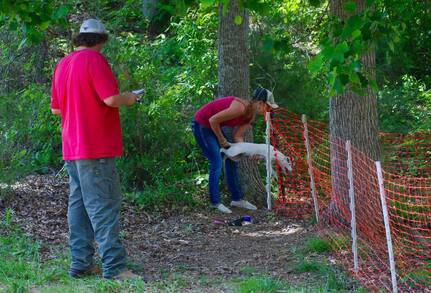
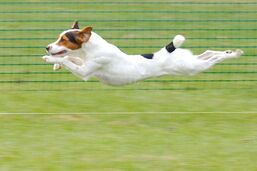
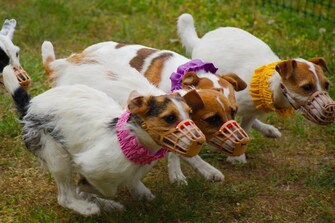
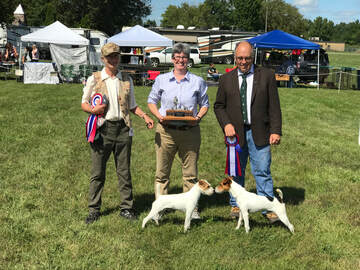
 RSS Feed
RSS Feed 